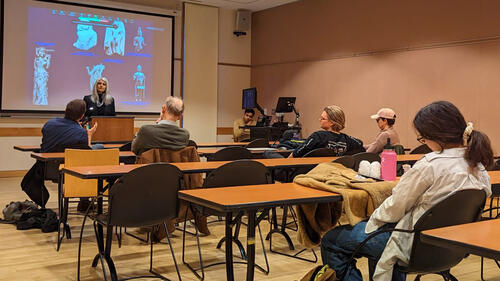When Divya Kumar-Dumas YC ‘98 graduated from Yale, there was no South Asian Studies
major. That has not stopped Kumar-Dumas from making a mark in the study of South Asia. In a
SASC Special Series event on Monday, April 3, Kumar-Dumas, who is currently a Research
Affiliate at the Institute for the Study of the Ancient World at New York University, returned to
Yale. Her lecture on “Moving Images Across the Early Indian Ocean” explored the interaction
between Indian Ocean landscapes and the movement of figures across the ancient Indian Ocean
world and articulated how stories and primary sources can help reconstruct the experience of
different landscapes. The lecture pulled together these thematic strands to offer three speculative
object biographies of objects from across the ancient Indian Ocean world.
Kumar-Dumas began her presentation with an overview of archaeological evidence of Indian
maritimers in an expanse stretching from Italy to Thailand during the first millennium CE and a
description of the epigraphic and iconic record. She then presented the central questions of her
talk: “Why were they moving images? What was it about these types of images that made
someone put our specific example onto a boat, in each case?” Kumar-Dumas described the
process of answering these questions as one of recovering intentions from landscape to construct
stories of the past.
The first of the three objects Kumar-Dumas dealt with in her presentation was the Pompeii ivory,
also known as the Pompeii Lakshmi, which has been variously interpreted as a luxury object, a
table leg, a yakshi [a nature spirit], a bulk commodity, or a unique piece of art. She also
discussed a terracotta figure from Adulis, in Eritrea, and the Sumhuram Yakshi, from Oman. In
her discussion of the various pieces, Kumar-Dumas drew links to production sites in South Asia,
the motivations of travelers carrying or shipping goods, the votive and secular meaning of the
objects to their holders, and the ways in which each object may have related to a set of material,
ritual, and aesthetic economies current in the Indian Ocean of the time.
Kumar-Dumas concluded the talk by describing the three meanings inherent in “moving
images.” She began by comparing moving images to early film and describing the objects she
analyzed as symbols of Indian ocean trade and displacement. The second meaning was one of
moving objects, which Kumar-Dumas used to argue that the objects index past unrecorded
figures and serve as emblems of transculturality. Finally, Kumar-Dumas described the images as
ones that move us—that provoke responses—as icons and images of divinities made with care.
She ended by saying that Indian images are multi-valent, both secular and sacred and many
things at once.
The lecture was attended by 30 people in a hybrid format.


